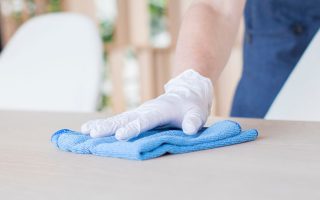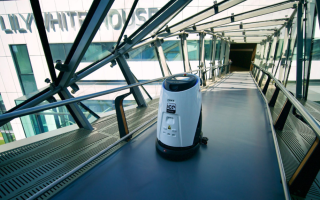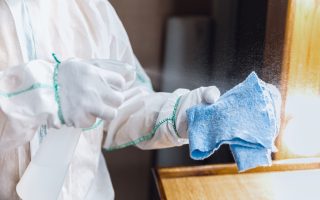Effective cleaning procedures are important in every setting, but it’s perhaps within hospitals when they are at their most crucial – especially when it comes to successful infection control.
By maintaining a high standard routine cleaning system, hospitals can reduce the spread of infections and illness throughout the wards. However, should an area of the hospital become exposed to a potentially dangerous infection, it’s vital that a thorough terminal cleaning procedure is put into action right away.
Given the importance of terminal cleaning, those with the task of putting such procedures into place should strive to improve their systems wherever possible. Read on for our guide to ways that you can improve terminal cleaning processes in a healthcare setting.
What is terminal cleaning?
Terminal cleaning is a precautionary cleaning procedure in which all surfaces (including walls and floors), furniture and re-useable equipment within an affected area are thoroughly cleaned and disinfected.
When discussing what is a terminal clean in a hospital, the procedure is usually as follows. A terminal cleaning system is generally put into action following a scenario in which there’s a risk of an infection outbreak. These circumstances may follow the discharge, transfer or death of an infected patient, dangerous contact between an infected patient and an uninfected person(s) within the hospital or simply an increase in the level of risk posed by the infection.
Essentially, if there is a confirmed or potential outbreak of any potentially dangerous infection, terminal cleaning in hospital procedures must be initiated immediately after the area has been vacated.
It’s crucial that everyone involved within a terminal cleaning team knows exactly how the terminal cleaning routine will unfold, as well as what their individual responsibilities will be and the PPE that must be worn.
What should your terminal cleaning plan include?
You should have a step-by-step terminal cleaning plan set in place, ready to roll out in the eventuality that you need it.
We’ve suggested below how this plan should look:
- Collect all products and equipment required for your terminal cleaning procedures to take place. This includes mops and buckets, clothes, clinical waste disposal bags, wet floor signs, vacuum cleaners and any pre-mixed cleaning solutions.
- This equipment should be colour-coded to avoid cross-contamination. Red equipment should be used for toilets, bathrooms and other such areas susceptible to the spread of harmful germs, blue for general cleaning, green for kitchens and food preparation areas and, finally, yellow for infectious isolation areas.
- Before entering the affected area, carefully put on the appropriate Personal Protective Equipment (PPE) using best donning practices.
- Prepare any additional cleaning solutions. These should be prepared according to manufacturer instructions and should be kept only in their designated bottles.
- Ensure that the affected area is appropriately ventilated – open windows and, if necessary and safe to do so, doors. This is due to the potentially harmful fumes caused by some disinfectants.
- Begin cleaning and disinfecting procedures, taking special care to adhere to the Control of Substances Hazardous to Health (COSHH) regulations throughout the process.
- Ensure you have identified any products that may need to rinse away after application. Rinse these away with water before drying.
- Safely dispose of any cloths, paper rolls and mop heads used during the terminal clean using a clinical waste disposal bag. Do this before leaving the affected area to avoid worsening the risk of infection exposure.
- Remove all PPE using best doffing practices and dispose of all used PPE using clinical waste disposal bags.
- Thoroughly wash and sanitise your hands after disposing of your PPE.
- Ensuring that all staff familiarise themselves with this process will streamline your terminal cleaning procedures and reduce the risk of mistakes being made.
Provide in-depth training
All staff positioned within your terminal cleaning team should receive substantial comprehensive training to prepare them for the event of the procedures being put into action.
Staff should be given a thorough verbal rundown of the steps involved before, during and after the clean, with the team questioned on these steps to ensure that they have received sufficient training to carry out terminal cleaning in hospital.
Teams may also benefit from printed resources that will help them to retain this information over time, with these resources placed in an area where the team will see them regularly.
Keep cleaning resources on-hand
If possible, have an inventory of the products and equipment needed for your terminal cleaning procedures kept always prepared.
These should be in an area where they are unlikely to be used during general cleaning procedures accidentally.
It goes without saying that time is of the essence when disinfecting an area with the aim of containing an infection. By having all products and PPE ready and waiting to be used, the time that would be spent preparing these products in the event of a terminal clean being ordered can be used to put procedures into action as swiftly as possible.
Outsource terminal cleaning to a professional team
At Samsic UK, we offer a wide range of facilities management services to organisations across multiple sectors, healthcare being just one.
Our contract cleaning services are tailored to the individual needs of every client. If it’s a skilled terminal cleaning team you require, we can assure you that our dedicated team of experienced cleaners are up to the task.
For information on any of our services, contact Samsic today.







